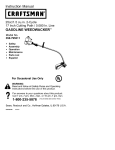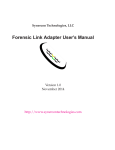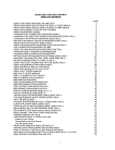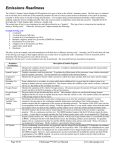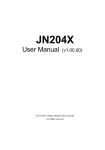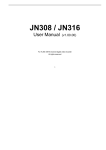Download Instrument Cluster - Central States Bus Sales, Inc.
Transcript
Directory Previous Previous Next Search Exit Instrument Cluster Table of Contents Sub-Headings Safety Warnings Cautions Notes Introduction Description of Operation Replacing Bulbs Calibrate Speedometer Instrument Panel and Controls Dash and Instrument Panel Indicator Light Panel 2 2 2 2 2 2 2 2 3 3 4 List of Figures Figure 1—Typical Light Assembly Figure 2—Ring Mount and Terminal Figure 3—Instrument Gauges and Controls Figure 4—Instrument Light Panel 3 3 4 5 List of Tables Table 1—Water Gauge Table 2—Transmission Oil Temperature Gauge Table 3—Oil Pressure Gauge Table 4—Fuel Level Gauge Table 5—Mating Connectors and Terminals All American Instrument Cluster 5 5 6 6 6 1 Directory Previous Previous Next Search Instrument Cluster Safety The purpose of this safety summary is twofold. First, it is to help ensure the safety and health of individuals performing service and maintenance on, or operation of, the Blue Bird All American Series bus. Second, it is to help ensure the protection of equipment. Before performing any service, maintenance or operating procedure on this product, individuals should read and adhere to the applicable warnings, cautions and notes located throughout this Blue Bird Service Manual. Warnings Warnings apply to a procedure or practice that, if not correctly adhered to, could result in injury or death. Particular attention should be paid to sections of this manual where warnings appear. Cautions Cautions apply to a procedure or practice that, if not correctly adhered to, could result in damage to or destruction of equipment. Exit 3. Remove bulb. 4. Replace new bulb. 5. Replace hand ring mount. Hand tighten hand ring mount. Calibrate Speedometer 1. Depress and hold the speedometer button. 2. Switch the ignition on. Note A pulse should show on the LCD display. 3. Release the speedometer button. 4. Wait 10 seconds for a series of pulses per mile number to flash on the LCD display. 5. As each new number flashes, depress and hold the speedometer button until the correct number appears. 6. After entering numbers, wait 10 seconds for the speedometer to return to the normal operating mode. Note The calculation used for the pulses per mile is teeth times tire RPM times axle ratio. 1. Depress and hold the tachometer button. 2. Switch the ignition on. Notes Note Notes are used to explain, clarify, or otherwise give additional insight for a given subject, product or procedure. Please note that on occasion, notes too may advise of potential safety issues. A pulse should show on the LCD display. Description of Operation Replacing Bulbs 3. Release the tachometer button. Wait 10 seconds for a series of pulses-perengine-revolution numbers to flash on the LCD display. 4. As each number flashes, depress and hold the tachometer button until the correct number shows for the speedometer to return to the normal operating mode. 1. Disconnect the electrical harness from the gauge. 2. Unscrew the hand ring mount. 2 All American Instrument Cluster Directory Previous Previous Next Search Exit Instrument Panel and Controls Dash and Instrument Panel Figure 1—Typical Light Assembly Figure 2—Ring Mount and Terminal All American Instrument Cluster 1. Anmeter—indicates battery charge and discharge. Figure 3—Instrument Gauges and Controls. 2. Transmission Fluid Temperature Gauge—indicates transmission temperature. 3. Front Air Gauge—indicates air pressure in front brake reservoir. 4. Fuel Gauge—indicates fuel level. 5. Speedometer—indicates vehicle speed. 6. Tachometer—indicates engine speed. 7. Oil Pressure Gauge—indicates engine oil pressure. 8. Coolant Temperature Gauge—indicates engine coolant temperature. 9. Voltmeter—indicates electrical system voltage. 10. Transmission Retarder Switch— activates transmission retarder function. 11. Headlight Switch—first position activates from park lights, rear tail lights and headlights. 12. Dimmer Switch—adjusts light level on instrument panel. 13. High Idle Switch—sets engine at high idle speed. 14. Low Idle Adjustment (Cummins ISB and ISC engines)—low engine idle speed can be adjusted between 700 and 875 rpm. The operator adjusts this speed in increments of 25 rpm, and the new idle speed is saved when the key switch is turned off. 15. Rear Air Gauge—indicates air pressure in rear brake reservoir. 16. Indicator Light Panel—see Indicator Light Panel. 17. Clock—digital. 18. Sanders—operates sanders function. 19. Secondary Shift—activates the transmission shift function. 20. Cruise Control On/Off Switch— activates or inactivates the cruise standby mode. 3 Directory Previous Previous Next 21. Cruise Set/Resume Switch—when vehicle reaches desired cruise speed, set speed by depressing. 22. The SET switch—when the vehicle drops below 30 mph or brake pedal is Search Exit depressed, the cruise returns to standby mode. To reactivate to preset speed, depress the RESUME switch. Figure 3—Instrument Gauges and Controls Indicator Light Panel Warning In the case of a brake system failure, a warning buzzer will sound and warning light will illuminate, indicating trouble. The coach must not be operated under these conditions. 1. Left Turn Direction—green light flashing indicates left turn signal. 2. Stop Light—red light indicates that service brake is applied. 3. Anti-Lock—amber light indicates fault in anti-lock brakes system (ABS). 4. Parking Brake—red light indicates that parking brake is engaged. 5. Brake System—red light indicates that hydraulic brake pressure is below safe limits. 4 6. Engine Maintenance Service—amber light indicates need for regular routine maintenance. 7. Service Engine Soon—amber light indicates that engine requires service soon. 8. Stop Engine (Optional)—red light indicates that engine must be stopped immediately. 9. Service engine Soon (Alternate position)—may appear in this position depending on options package. 10. Alternator—amber light indicates malfunction in alternator in dualalternator option. 11. High Beams—blue light indicates that headlights are in high beam. 12. Low Coolant Level—amber light indicates that coolant is low. 13. Hydraulic Oil Temp—amber light indicates that the hydraulic temperature is out of limits. All American Instrument Cluster Directory Previous Previous Next Search Exit 19. Low Air—red light with buzzer indicates that air brake pressure is low. 20. Range Inhibit—amber light indicates that transmission is restricting shifts. 21. Check Transmission—red light indicates that transmission requires service. 22. Transmission Temperature—amber light indicates that transmission temperature is out of limits. 14. Right Turn Directional—green light flashing indicates right turn signal. 15. Engine Retard (Optional)—red light indicates that the engine retarder is engaged. 16. Sanders Refill—red light indicates that sand quantity is low. 17. Traction Control (Optional)—amber light indicates that traction control is engaged. 18. Wait to Start—green light indicates engine preheating. Wait until it turns off before starting engine. Figure 4—Instrument Light Panel Gauge Specification Water Gauge Measuring Range 100° to 250° F 100° 120° 140° 160° 180° 190° 200° 210° 220° °F 3.6 8.3 16.4 30.3 40 46.6 59 66.3 Deflection 0 287.4 190 134 92 62 51.3 46 38 34 Ω Movement Number 999-010-008 Table 1—Water Gauge 230° 75.2 29.4 250° 88.2 22 375° 84 18 400° 88.6 14.5 Oil Gauge Measuring Range 150° to 400° F 150° 175° °F 3.75 Deflection 0 482.5 270 Ω 200° 7.9 182 225° 15.3 120 250° 25.2 82 275° 39.6 56 300° 54.2 41 325° 67.3 30.5 350° 77.3 23 Movement Number 999-010-012 Table 2—Transmission Oil Temperature Gauge All American Instrument Cluster 5 Directory Previous Previous Next Search Exit Oil Pressure Gauge Measuring Range 0 to 150 PSI PSI Deflection 0 10 Ω 10 5 26 20 10.1 40 30 15.6 53 40 22.3 67 50 28.3 78 60 35.8 90.5 70 44.1 103 80 52.3 115 90 60.2 127 100 67 138 Movement Number 999-010-009 Table 3—Oil Pressure Gauge Oil Pressure Gauge Measuring Range 0 to 150 PSI (continued) 110 120 130 140 150 PSI 73.1 78.4 82 85.3 88.1 Deflection 149 160 169 178 184 Ω Movement Number 999-010-009 Table 3—Oil Pressure Gauge (continued) Fuel Gauge Range Empty to Full E Range Deflection 3.9 6 Ω 1/8 9.4 13.5 1/4 17.1 22.5 3/8 27.7 33 1/2 42.5 45 5/8 57.7 56 3/4 70.9 67.5 7/8 79.5 76.5 F 83.7 82 Movement Number 999-010-001 Table 4—Fuel Level Gauge Mating Connectors and Terminals Gauge Bulb AMP P/N 925276-0 AMP P/N 926521-2 BB P/N 0002697 AMP P/N 160825-4 AMP P/N 154718-3 BB P/N 0002696 Table 5—Mating Connectors and Terminals 6 All American Instrument Cluster Directory Previous Previous Next Search Exit Troubleshooting and Diagnostics Symptom Check Corrective Action Speedometer reading incorrect speed. Using cluster configuration manager, check tire rpm and axle ratio. Reprogram dash to correct tire rpm and axle ratio. See Programming and Viewing Cluster Configuration. Replace speed sensor or ECM. Check speed sensor for proper signal or correct signal from engine ECM. Check wiring from speed sensor to BB1 cluster. Speedometer pointer does not move from zero position. Speedometer pointer does not move from one point. Tachometer reads incorrect RPM. Note: ISB and ISC Engine. ECMs produce Tach signal from Instrument Cluster. Speed sensor frequency is lower than minimum. Check wiring from speed sensor to BB1 cluster. Speed sensor frequency is higher than maximum. Check wiring from speed sensor to BB1 cluster. Using cluster configuration manager, check tachometer setting. Check alternator for signal interference (Mechanical Engine). Check wiring from alternator to BB1 cluster. (Mechanical engine.) Fix or replace bad wiring, correct any outside noise interference. Cluster connector. Change speed sensor. Fix or replace bad wiring. Correct any outside noise interference. Cluster connector. Change speed sensor. Fix or replace bad wiring, correct any outside noise interference. Cluster connector. Remove and Replace BB1 Instrument Cluster. Reprogram dash to correct setting. See Programming and Viewing Cluster Configuration. Note: Setting is set with engine template. Move signal wire from one stator leg to another. Fix or replace bad wiring, correct any outside noise interference. Cluster Connector. Back to Top All American Instrument Cluster 7







